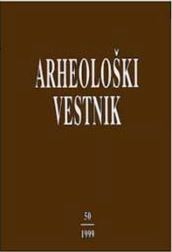Psi z ižanskih najdišč v Narodnem muzeju Slovenije
Povzetek
Med določanjem prazgodovinskih koščenih izdelkov, najdenih v 19. stoletju pri izkopavanjih v bližini Iga na Ljubljanskem barju, sem izmeril osem lobanjskih odlomkov psov in spodnje derače (M1) 37 psov in 4 volkov, da bi rekonstruiral velikost in fizični tip prazgodovinskih živali. Na podlagi celih komolčnic (ulnae) še dveh osebkov sem ocenil plečno višino psov iz najdišča. Derače psov sem primerjal z derači volkov iz najdišča, za nameček pa sem primerjal še lobanjske mere in plečno višino z ustreznimi podatki rimskodobnih mestnih psov, ki so poznani po veliki variabilnosti v velikosti. Nazadnje sem ugotovitve z najdišča pri Igu primerjal s podatki za ostanke psov iz objezerskih naselbin v Švici in severni Italiji od neolitika do bronaste dobe. Izračuni so potrdili staro domnevo, da pripadajo ostanki psov, ki so bili najdeni pri Igu, barjanskemu (močvirskemu) tipu psa (C. familliaris palustris), ki ga širše obravnavam v svojem članku.
Prenosi
Literatura
BARTOSIEWICZ, L. 1989, Animal remains from the fort. - In: D. Gabler (ed.), The Roman fort of Ács-Vaspuszta (Hungary) on the Danubian limes, BAR Brit. Ser. 531, Partii, 600-623.
BARTOSIEWICZ, L. 1994, Late Neolithic dog exploitation: chronology and function. - Acta Arch. Acad. Sc. Hung. 46, 59-71.
BARTOSIEWICZ, L. 1999, Recent developments in archaeo-zoological research in Slovenia. - Arh. vest. 50, 285-295.
BARTOSIEWICZ, L. 2000, Metric variability in Roman perioddogs in Pannonia provincia and the Barbaricum, Hungary. - In: S. J. Crockford (ed.), Dogs through time: an archaeologicalperspective, BAR Int. Ser. 889, 181-192.
BECKER, C. and F. JOHANSSON 1981, Tierknochenfunde. - Die neolithischen Ufersiedlungen von Twann11, Bern.
BOESSNECK, J., J.-P. JÉQUIER and H. R. STAMPFLI 1963, Seeberg Burgäschisee-Süd 3. Die Tierreste, Acta Bernensia2, Bern.
BÖKÖNYI, S. 1974, History of domestic mammals in Centraland Eastern Europe. - Budapest.
BUFFON, G. L. L. (1749-1788), Histoire naturelle. - Paris.
BUFON, Z. 1971, K stopetdesetletnici prirodoslovnega muzejaSlovenije v Ljubljani (Zum hundertfünfzigjährigen Jubiläumdes Naturgeschichtlichen Museums in Ljubljana). - Argo10, 164-200.
DENNIS-BRYAN, K. and J. CLUTTON-BROCK 1988, Dogsof the last hundred years at the British Museum (NaturalHistory). - London.
DESCHMANN, K. 1875, Die Pfahlbaufunde aus dem LaibacherMoore. - Verhandlungen der k. u. k. geologischen Reichsanhalt15, 275-284, Wien.
DESCHMANN, K. 1876, Bericht über die Pfahlbauten-aufdeckungen im Laibacher Moore. - Sitzber. Phil.-hist. Cl. k. k. Akad. Wiss. 84, 471-484, Wien.
DRIESCH, A. von den 1976, A guide to the measurement ofanimal bones from archaeological sites. - Peabody MuseumBulletin 1, Cambridge, Mass.
DROBNE, K. 1963, Subfosilni živalski ostanki iz mostiščarskedobe na Ljubljanskem Barju I-II. - Dissertation, Inštitutza geologijo Univerze v Ljubljani, Ljubljana.
DROBNE, K. 1975, Fauna količarskih naselbin na Ljubljanskembarju. - Arh. vest. 24, 217-224.
DROBNE, K. 1983, Bronzezeitliche Wild- und Haustiere amLjubljaner Moor (Jugoslawien). - In: M. Kubasiewicz (ed.) Archaeozoology I. Proceedings of the 3rd Conference of theInternational Council for Archaeozoology 1978, 577-579, Szczecin.
EIBL, F. 1974, Die Tierknochenfunde aus der neolitischen StationFeldmeilen-Vorderfeld am Zürichsee I. Die Nichtwiederkäuer. - Diss. Institut für Paläoanatomie, Domestikationsforschungund Geschichte der Tiermedizin der Universität München, München.
GREIF, T. 1997, Prazgodovinska kolišča na Ljubljanskembarju. - Arheo 18, 1-95.
HESCHELER, K. and J. RÜEGER 1942, Die Reste der Haustiereaus den neolitischen Pfahlbaudörfern Egolzwil 2 (Wauwilersee, Kt. Luzern) und Seematte-Gelfingen (Baldeggersee, Kt. Luzern). - Vierteljahrschrift der Naturforschenden GesellschaftZürich 87, 383-486.
HILZHEIMER, M. 1932, Römische Hundeschädel aus Mainz, ein fränkischer Hundeschädel und ein Hundeschädel des 15. oder 16. Jahrhunderts ebendaher. - Biol. gen. 8, 91-126.
HÜSTER-PLOGMANN, H. and J. SCHIBLER 1997, Archäozoologie. - In: J. Schibler et al. (eds), Ökonomieund Ökologie neolitischer und bronzezeitlicher Ufersiedlungenam Zürichsee, Monographien des Kantonsarchäologie Zürich20, 40-121.
KOUDELKA, F. 1885, Das Verhältnis der Ossa longa zurSkeletthöhe bei Säugertieren. - Verh. d. Naturforsch. Verein24, Brünn.
MENZEL, K. M. 1960, Pariahunde. - Die Neue Brehm Bücherei, Wittenberg Lutherstadt.
PARZINGER, H. 1984, Die Stellung der Uferrandsiedlungenbei Ljubljana im äneolitischen und frühbronzezeitlichenKultursystem der mittleren Donauländer. - Arh. vest. 35, 13.
PUCHER, E. and K. ENGL 1997, Studien zur Pfahlbauforschungin Österreich. Materialen I - Die Pfahlbaustationen desMondsees. Tierknochenfunde. - Mitt. Prähist. Komm. 33.
RIEDEL, A. 1976, La fauna del villaggio preistorico di Barchedi Solferino. - Atti del Museo Civico di Storia Naturale -Trieste 29/4, 215-318.
RIEDEL, A. 1989, Die Fauna einer bronzezeitlichen Siedlungbei Peschiera am Gardasee. - Rivista di Archeologia 6, 23-27.
RÜTIMEYER, L. 1862, Die Fauna der Pfahlbauten der Schweiz. - Neue Denkschrift der all. Gesellschaft d. ges. Naturwissnschaften 19.
SÁRKÁNY, P. and I. ÓCSAG 1977, Ungarische Hunderassen. - Budapest.
SCHIBLER, J. 1987a, Osteoarchäologische Untersuchungender neolitischen Knochenkomplexe. - In: P. J. Suter (ed.), Zürich “Kleiner Hafner”, 167-179, Zürich.
SCHIBLER, J. 1987b, Die Stichprobenanalyse desTierknochenmaterials. - In: E. Gross et al. (eds), Zürich “Mozartstrasse. Neolitische und bronzezeitliche Ufersiedlungen1, Berichte der Zürcher Denkmalpf lege, Monographien4, 190-197.
STAMPFLI, H. R. 1976, Osteo-archaeologische Untersuchungdes Tierknochenmaterials der spätneolitischen UfersiedlungAuvernier La Saunerie nach den Grabungen 1964 und 1965. - Solothurn.
VELUŠČEK, A. 1999, Neolithic and Eneolithic Investigationsin Slovenia. - Arh. vest. 50, 59-72.
Prenosi
Objavljeno
Kako citirati
Številka
Rubrike
Licenca

To delo je licencirano pod Creative Commons Priznanje avtorstva-Nekomercialno-Brez predelav 4.0 mednarodno licenco.
Avtorji jamčijo, da je delo njihova avtorska stvaritev, da v njem niso kršene avtorske pravice tretjih oseb ali kake druge pravice. V primeru zahtevkov tretjih oseb se avtorji zavezujejo, da bodo varovali interese založnika ter da bodo povrnili morebitno škodo.
Podrobneje v rubriki: Prispevki





